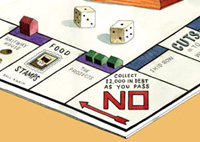
Bruce Katz of Brookings, writing recently in the Chronicle of Higher Education, reminds us that Hurricane Katrina laid bare a New Orleans starkly divided by race and class, with the brunt of the disaster being being borne by poor, minority households. (Before Katrina, African-American residents made up 67 percent of the city’s total population, but 84 percent of its population below the poverty line. And those poor African-American households were highly concentrated in 47 neighborhoods of extreme poverty, where the poverty rate topped 40 percent.) But, as he points out, though New Orleans has always been one of the cities with the most geographically concentrated poor populations in the country, it’s hardly unique.
[Some] cities—like Baltimore, Cleveland, and Milwaukee—are former industrial giants whose populations have suffered from severe economic restructuring over the past several decades. Others—like Fresno, Los Angeles, and Miami—have faced challenges in integrating new immigrant populations who often arrive in gateway neighborhoods with low levels of education and labor-market skills. Still others—Atlanta, Memphis, and Washington—lie at the heart of growing regions but continue to grapple with legacies of racism, segregation, and intergenerational poverty holding back their most distressed neighborhoods.
The existence in our midst of concentrated poverty–complete with failing schools, unsafe streets, run-down housing, and few local jobs or employment networks –is a standing affront to American values and basic morality, of course. But, as Katz makes clear, it also entails a series of cascading effects that spread the cost to society at large.
- Cities are forced to pay for the higher cost of delivering health, education, police, fire, judicial, and other services in high-poverty environments, often amounting to hundreds of dollars per city resident.
- With higher expenses come higher taxes, harming cities in their competition for middle-class families, which are the backbone of resilient economies.
- Suburbs with weak central cities see less appreciation in housing prices and incomes, given the interdependence of economies.
- The concentration of neighborhood poverty leads inexorably to the concentration of school poverty.
So, what to do? Katz points out that there are available policy tools, focused on broadening access to affordable housing, employment, and educational opportunities–designed to transform poor neighborhoods into healthy ones attracting families with a broad range of incomes. He concludes:
The bottom line is that America knows how to promote housing choice and build mixed-income communities that work economically and socially. The only question is whether we have the political will to apply the best lessons and innovations not only to the rebuilding of New Orleans but to the housing of Katrina-displaced and other low-income families throughout the country.
(For more on how the poor get poorer–and the rich get richer–see the two most recent issues of Mother Jones, in which Clara exhaustively details how the deck is stacked against poor Americans and very much in favor of wealthy ones — in ways that aren’t always obvious.)















